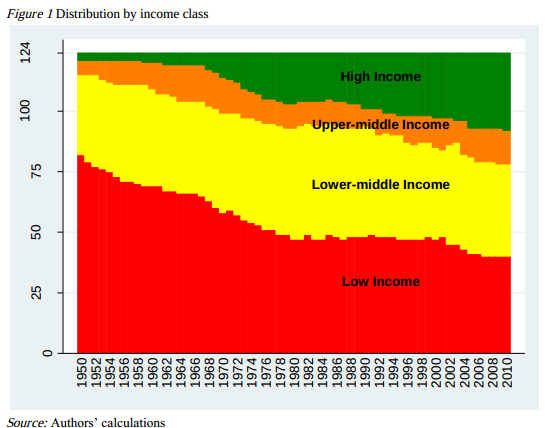

| Visitors Now: | |
| Total Visits: | |
| Total Stories: |

| Story Views | |
| Now: | |
| Last Hour: | |
| Last 24 Hours: | |
| Total: | |
Middle-income Trap – Which countries are in it and why ?
From
ABSTRACT -This paper provides a working definition of what the middle-income trap is. We start by defining four income groups of GDP per capita in 1990 PPP dollars: low-income below $2,000; lower-middle-income between $2,000 and $7,250; upper-middle-income between $7,250 and $11,750; and high-income above $11,750. We then classify 124 countries for which we have consistent data for 1950–2010. In 2010, there were 40 low-income countries in the world, 38 lower-middle-income, 14 upper-middle-income, and 32 high-income countries. Then we calculate the threshold number of years for a country to be in the middle-income trap: a country that becomes lower-middle-income (i.e., that reaches $2,000 per capita income) has to attain an average growth rate of per capita income of at least 4.7 percent per annum to avoid falling into the lower-middle-income trap (i.e., to reach $7,250, the upper-middle-income threshold); and a country that becomes upper-middle-income (i.e., that reaches $7,250 per capita income) has to attain an average growth rate of per capita income of at least 3.5 percent per annum to avoid falling into the upper-middle-income trap (i.e., to reach $11,750, the high-income level threshold). Avoiding the middle-income trap is, therefore, a question of how to grow fast enough so as to cross the lower-middle-income segment in at most 28 years, and the upper middle-income segment in at most 14 years. Finally, the paper proposes and analyzes one possible reason why some countries get stuck in the middle-income trap: the role played by the changing structure of the economy (from low-productivity activities into high-productivity activities), the types of products exported (not all products have the same consequences for growth and development), and the diversification of the economy. We compare the exports of countries in the middle-income trap with those of countries that graduated from it, across eight dimensions that capture different aspects of a country’s capabilities to undergo structural transformation, and test whether they are different. Results indicate that, in general, they are different. We also compare Korea, Malaysia, and the Philippines according to the number of products that each exports with revealed comparative advantage. We find that while Korea was able to gain comparative advantage in a significant number of sophisticated products and was well connected, Malaysia and the Philippines were able to gain comparative advantage in electronics only.
See more and subscribe to NextBigFuture at 2012-12-12 14:02:44 Source: http://nextbigfuture.com/2012/12/middle-income-trap-which-countries-are.html
Source:



